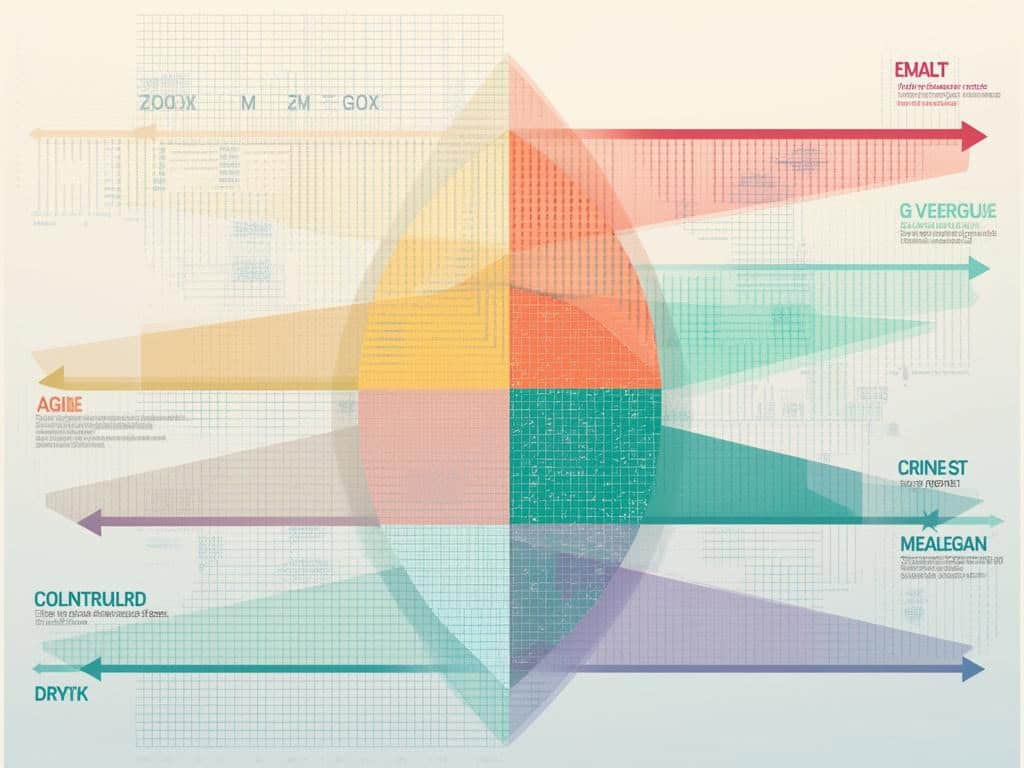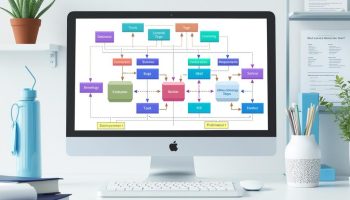
Project Management Governance Framework Types
Project management governance framework types deliver structured approaches to decision-making, accountability, and strategic alignment across organizational initiatives. Five primary governance models—Collaborative, Agile, Decentralized, Functional, and Hierarchical—offer distinct strategies for managing projects, each matched to specific organizational needs and project requirements.
Key Takeaways:
- Project governance frameworks improve project performance by establishing clear decision-making processes and accountability mechanisms.
- The five primary governance models include Collaborative, Agile, Decentralized, Functional, and Hierarchical frameworks.
- Effective governance requires identifying stakeholders, defining clear roles, and establishing transparent communication channels.
- Organizations with strong governance frameworks are more likely to deliver projects on time and within budget.
- Governance frameworks should be flexible and adaptable to changing organizational requirements.
Implementing the right governance framework creates a foundation for project success. Each model serves different organizational structures and project types, making your selection critical for achieving optimal results.
Governance Models
The Collaborative model promotes cross-functional teamwork and shared decision-making, perfect for complex projects requiring diverse expertise. This approach encourages innovation through collective problem-solving while maintaining clear accountability.
For fast-changing environments, the Agile governance framework provides flexibility and rapid adaptation. This model supports iterative development cycles and frequent stakeholder feedback, helping you maintain project relevance despite shifting requirements or market conditions.
Organizations with distributed teams often benefit from the Decentralized governance model. This approach empowers local decision-making while maintaining strategic alignment through established guidelines and reporting structures.
Traditional organizations typically employ Functional governance, organizing projects by department or specialty. This creates clear responsibility chains but requires strong coordination across functional boundaries.
The Hierarchical model implements top-down control with centralized authority. This framework excels in regulated industries where compliance and risk management take priority over flexibility.
Choosing the Right Governance Framework
Your governance selection should align with organizational culture, project complexity, and strategic goals. Many successful organizations implement hybrid approaches, combining elements from multiple frameworks to create custom solutions that address specific challenges.
Regular assessment and adjustment of your governance framework ensures continued effectiveness. As your organization grows and projects evolve, your governance approach should adapt to maintain optimal performance and strategic alignment.
“Effective project governance frameworks are the backbone of successful initiatives, providing clarity in decision-making and accountability while aligning with organizational strategy. By embracing tailored governance models—be it Collaborative, Agile, Decentralized, Functional, or Hierarchical—organizations can enhance performance and adaptability, ensuring projects are delivered on time and within budget.”
Understanding Project Governance Frameworks
A project management governance framework types establish clear decision-making processes that align your projects with organizational strategy. These frameworks create a structured approach to ensure accountability, transparency, and consistent project delivery. When you implement proper governance, you’ll experience a 37% improvement in project performance according to the 2021 PMI survey.
Core Components of Effective Project Governance
Your project management governance framework types need these essential elements to function effectively:
- Strategic Alignment: Ensures projects support your organization’s goals and objectives
- Accountability Mechanisms: Clearly defines who’s responsible for decisions and outcomes
- Transparent Communication Channels: Facilitates information flow between all stakeholders
- Risk Management Protocols: Identifies, assesses, and mitigates project risks systematically
To select the right project management governance framework types for your organization, consider these five primary models:
- Collaborative Governance: Emphasizes shared decision-making among stakeholders, ideal for complex initiatives requiring diverse expertise
- Agile Governance: Focuses on flexibility and rapid adaptation, perfect for fast-changing environments
- Decentralized Governance: Distributes authority across teams, suitable for organizations with strong autonomous units
- Functional Governance: Aligns projects within specific departments, best for specialized work
- Hierarchical Governance: Establishes clear reporting structures, effective for large, complex organizations
Each governance model varies in its approach to decision-making authority, stakeholder involvement, and flexibility. When implementing project assurance processes, your governance framework will determine how oversight functions.
Your PMO can adopt different governance structures depending on organizational needs:
- Centralized: All project governance flows through a single PMO
- Hub-and-Spoke: Central PMO coordinates with satellite PMOs in different departments
- Distributed: Multiple independent PMOs operate with coordination mechanisms
The effectiveness of your governance framework depends on adhering to key principles including single-point accountability, separation of project ownership from service ownership, and stakeholder satisfaction management processes. When you implement these principles consistently, you’ll create balanced decision-making frameworks that support project success.
To develop an effective project management governance framework, you should identify all stakeholders, define clear roles and responsibilities, establish transparent processes, and implement performance monitoring mechanisms. This approach will help you maximize governance effectiveness through improved strategic alignment and enhanced risk management capabilities.

Governance Model Landscape
The project management governance framework types you select directly impact your project outcomes. With the right governance structure in place, you’ll create clearer decision pathways and improve accountability throughout your organization. Understanding the different project management governance framework types helps you select the one that best fits your organizational needs.
Five Primary Governance Framework Types
You’ll encounter five major project management governance framework types when structuring your projects:
- Collaborative Governance Framework – This framework emphasizes shared decision-making across teams and departments. You’ll find this approach effective when project management governance framework types need to support cross-functional initiatives requiring diverse expertise. It distributes accountability among team members while maintaining a collaborative project environment that encourages innovation.
- Agile Governance Framework – Designed for flexibility and rapid adaptation, this framework supports iterative development and continuous improvement. Your governance processes will have fewer formal controls while emphasizing stakeholder feedback and regular project reassessment. This project management governance framework type works best for projects with evolving requirements or uncertain deliverables.
- Decentralized Governance Framework – Authority and decision-making capabilities are distributed throughout the organization in this framework. Your teams gain autonomy while maintaining alignment through shared principles rather than rigid controls. This approach enhances responsiveness but requires strong project communication channels to prevent fragmentation.
- Functional Governance Framework – Organized around specific business functions, this project management governance framework type creates clear domains of responsibility. You’ll find this helpful when projects need specialized expertise within established departments. Decision-making follows existing organizational hierarchies while reinforcing departmental accountability.
- Hierarchical Governance Framework – This traditional approach establishes clear chains of command with centralized decision-making authority. Your governance structure will feature formal escalation paths and standardized processes, making it suitable for high-risk projects requiring tight controls and steering group oversight.
The table below summarizes how these project management governance framework types differ in key dimensions:
| Framework Type | Decision Authority | Stakeholder Involvement | Flexibility | Ideal Project Types |
|---|---|---|---|---|
| Collaborative | Shared | High | Moderate | Cross-functional, innovation-focused |
| Agile | Team-based | Very high | Very high | Technology, product development |
| Decentralized | Distributed | Moderate | High | Multi-site, diverse initiatives |
| Functional | Department-based | Low-Moderate | Low | Specialized, department-specific |
| Hierarchical | Centralized | Low | Very low | Regulated, high-risk, traditional |
Selecting the appropriate project management governance framework type depends on your organizational culture, project complexity, and strategic objectives. You’ll need to assess your specific project requirements before implementing a governance structure that enhances project success rather than creating bureaucratic obstacles.
Effective project governance can improve project delivery performance by up to 30%.
cio.com
PMO Governance Structures
Your Project Management Office (PMO) requires a well-defined governance structure to effectively oversee and control project management governance framework types throughout your organization. Each framework type offers distinct advantages depending on your organizational context and project requirements.
The three primary PMO governance framework types include centralized, hub-and-spoke, and distributed models, each with unique characteristics that impact your project oversight and organizational effectiveness.
Centralized PMO Governance
A centralized project management governance framework establishes a single authority point that oversees all project activities across your organization. This approach creates consistency in project management governance framework types implementation and decision-making.
Benefits of this structure include:
- Standardized methodologies across all projects
- Clear escalation paths for issues and decisions
- Consolidated reporting and metrics
- Efficient resource allocation
- Strong strategic alignment with organizational objectives
However, centralized governance may create bottlenecks in project communication and slow decision-making processes in fast-moving environments.
Hub-and-Spoke Model
The hub-and-spoke model balances central oversight with localized control. Your central PMO establishes standards and governance frameworks while departmental “spokes” implement and adapt them to specific needs. This project management governance framework type works well for organizations with diverse business units requiring tailored approaches.
Distributed Governance Model
The distributed governance model disperses project management governance framework types authority across different departments or business units. This approach maximizes flexibility but requires robust project collaboration mechanisms to maintain alignment.
Factors Influencing PMO Governance Model Selection
Several factors influence your PMO governance model selection:
- Organizational culture and structure
- Project complexity and diversity
- Geographic distribution
- Regulatory requirements
- Resource availability
- Strategic importance of projects
When evaluating project management governance framework types, consider how each model affects:
- Decision-making speed
- Resource optimization
- Risk management capabilities
- Stakeholder engagement
- Strategic alignment
- Scalability
The most effective PMOs implement governance structures that balance control with flexibility. You’ll need established project management practices while allowing adaptation to changing business conditions.
Your governance framework should evolve as your organization matures. Start with clear documentation of processes, decision rights, and escalation paths. Regularly review effectiveness through performance metrics and stakeholder feedback to refine your approach.
Organizations with effective PMO governance structures are 28% more likely to achieve their project goals and have lower rates of project failure.
forbes.com
Key Governance Principles
Effective project management governance framework types rely on fundamental principles that create the foundation for successful project delivery. You’ll find that governance frameworks act as the backbone of your project management operations, providing structure while maintaining flexibility for changing organizational needs.
Core Project Management Governance Framework Types Principles
A single point of accountability stands as the cornerstone of all project management governance framework types. This principle ensures clear decision-making authority and prevents confusion about who’s responsible for critical project decisions. You can establish this by defining the project sponsor role with explicit accountability for project success.
The separation of project ownership from service ownership creates necessary checks and balances in your governance structure. This distinction prevents conflicts of interest and ensures independent oversight of project performance. When you implement this principle, you’ll see improved project management governance framework performance through objective evaluation.
Clear stakeholder management processes form another vital component of effective project management governance framework types. These processes help you identify, analyze, and engage stakeholders throughout the project lifecycle. Implementing stakeholder satisfaction strategies as part of your governance framework ensures all voices are heard and considered.
Balanced decision-making frameworks incorporate input from various organizational perspectives. This approach enhances the quality of decisions by considering multiple viewpoints and expertise. You can achieve this balance through:
- Establishing governance committees with cross-functional representation
- Creating clear escalation paths for decision-making
- Defining decision authority levels based on impact and risk
- Implementing structured decision processes with appropriate documentation
- Requiring business case justification for major project decisions
Transparency in project management governance framework types creates trust and facilitates better decision-making. You should establish regular reporting mechanisms that provide stakeholders with accurate project status information. This includes developing RAG status reporting systems that clearly communicate project health.
Successful project management governance framework types incorporate comprehensive risk management processes. You’ll need to establish protocols for identifying, analyzing, and responding to risks throughout the project lifecycle. Implementing effective risk response strategies within your governance framework helps maintain project stability.
| Governance Framework Type | Accountability Approach | Decision-Making Structure | Risk Management Focus |
|---|---|---|---|
| Hierarchical | Centralized with clear reporting lines | Top-down approval process | Formal risk assessment protocols |
| Collaborative | Shared accountability with defined roles | Consensus-based decision model | Collective risk identification |
| Agile | Product owner accountability | Empowered team decision-making | Iterative risk management |
| Decentralized | Business unit accountability | Distributed authority | Context-specific risk approaches |
| Functional | Department-level accountability | Function-based approvals | Specialized risk evaluation |
Organizations that adopt a strong governance framework for project management are 21% more likely to deliver projects on time and within budget.
hbr.org
Practical Implementation Strategies
Implementing an effective project management governance framework requires careful planning and consistent execution. You’ll need to follow strategic steps to develop a framework that enhances accountability while maintaining flexibility for your specific organizational needs.
Start by identifying all stakeholders who will participate in or be affected by your project management governance framework. This includes executives, project managers, team members, and external partners. Identifying key stakeholders early helps ensure your governance model addresses all crucial perspectives.
Next, define clear roles and responsibilities within your project management governance framework. Each person must understand their decision-making authority and accountability boundaries. Create a RACI matrix (Responsible, Accountable, Consulted, Informed) to document who handles specific governance activities. This prevents confusion and empowers team members to act within their designated authority.
Creating transparent processes forms the backbone of any governance framework. Document how decisions will be made, escalated, and communicated. Your process documentation should specify:
- Decision thresholds for different governance levels
- Required approvals for project changes
- Escalation pathways for issues
- Documentation standards for governance activities
Establishing robust communication channels ensures your project management governance framework functions effectively. Consider these communication strategies:
- Regular governance committee meetings
- Standardized reporting templates
- Digital collaboration platforms
- Decision logs for tracking governance actions
Implement performance monitoring mechanisms to evaluate your governance framework’s effectiveness. Strategic dashboards help track metrics like decision turnaround time, stakeholder satisfaction, and strategic alignment.
Several tools can strengthen your governance implementation:
- Decision matrices for evaluating options
- Project portfolio management software
- Process workflow diagrams
- Governance charters documenting authority boundaries
For continuous improvement of your project management governance framework, establish regular review cycles to assess what’s working and what needs refinement. Post-implementation reviews provide valuable insights for enhancing your governance approach.
Remember that effective governance balances control with flexibility. Too much rigidity creates bottlenecks, while too little structure leads to chaos. The right project management governance framework will provide structure while allowing appropriate autonomy for project teams.
Maximizing Project Governance Effectiveness
You’ll achieve superior project outcomes when you implement a robust project management governance framework types strategy. These structured approaches define how decisions are made, who’s accountable, and how projects align with organizational objectives. According to the 2021 PMI survey, organizations with well-defined governance frameworks experience significantly higher project success rates.
Types of Project Management Governance Frameworks
Different project management governance framework types serve distinct organizational needs:
- Collaborative Governance Framework – Emphasizes shared decision-making and team involvement. You’ll find this approach particularly effective for cross-functional projects requiring diverse expertise and stakeholder buy-in. This model enhances project collaboration across departments.
- Agile Governance Framework – Features iterative decision-making processes with frequent review points. This framework thrives in fast-paced environments where requirements evolve rapidly and agile methodologies are already established.
- Decentralized Governance Framework – Distributes authority across multiple project teams or business units. You’ll gain flexibility and responsiveness but need strong coordination mechanisms to prevent fragmentation.
- Functional Governance Framework – Organizes governance by departmental or functional areas. This approach works well when projects primarily impact specific business functions and technical expertise is concentrated.
- Hierarchical Governance Framework – Implements a clear chain of command for decision-making. Your organization can benefit from this structure when dealing with high-risk projects requiring strict risk response strategies.
Each framework offers distinct benefits for project management governance framework types implementation:
| Framework Type | Decision Authority | Stakeholder Engagement | Best For |
|---|---|---|---|
| Collaborative | Shared | High | Cross-functional initiatives |
| Agile | Iterative | Continuous | Fast-changing environments |
| Decentralized | Distributed | Varied | Multi-site operations |
| Functional | Department-based | Focused | Specialized projects |
| Hierarchical | Top-down | Structured | High-risk endeavors |
When selecting your project management governance framework types, consider:
- Your organizational culture and structure
- Project complexity and risk profile
- Stakeholder distribution and engagement needs
- Required speed of decision-making
- Regulatory compliance requirements
The most effective governance approaches establish clear project sponsor responsibilities and ensure transparent stakeholder identification. You’ll need mechanisms for monitoring project alignment with strategic goals, managing risks, and maintaining accountability at all levels.
By implementing the right project management governance framework types for your context, you’ll unlock benefits including:
- Enhanced strategic alignment between projects and organizational goals
- Improved risk identification and mitigation
- Greater stakeholder satisfaction through transparent processes
- More consistent project delivery performance
- Clearer decision pathways reducing delays and confusion
The project management governance framework types you select should evolve as your organization matures, adapting to changing business conditions while maintaining core governance principles.






